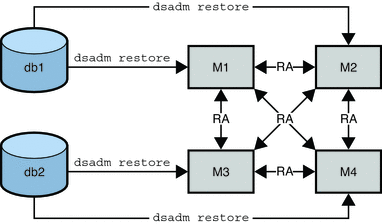Choosing a Restoration Method
Directory Server Enterprise Edition provides two methods of restoring data: binary restore and restoration from an LDIF file. As with the backup methods, both of these methods have advantages and limitations.
Binary Restore
Binary restore copies data at the database level. Binary restore is performed using one of the following commands:
-
dsadm restore must be run offline, that is, when the Directory Server instance is stopped. This command must be run on the local server containing the Directory Server instance.
-
dsconf restore can be run online and remote to the Directory Server instance.
Binary restore has the following advantages:
-
All suffixes can be restored at the same time.
-
The replication change log is restored.
-
Binary restore is significantly faster than restoring from an LDIF file.
Binary restore has the following limitations:
-
Restoration can be performed only on a server with an identical configuration, as defined in Binary Backup. For more information about restoring data with the binary restore feature, see Binary Restore in Sun Java System Directory Server Enterprise Edition 6.2 Administration Guide.
-
If you are not aware that your database was corrupt when you performed the binary backup, you risk restoring a corrupt database. Binary backup creates an exact copy of the database.
Binary restore is the preferred restoration method if the machines have an identical configuration and time is a major consideration.
The following figure assumes that M1 and M2 have an identical configuration and that M3 and M4 have an identical configuration. In this scenario, M1 or M2 can be restored from the binary backup of M1 (db1). M3 or M4 can be restored from the binary backup of M3 (db2).
Figure 8–4 Offline Binary Restore

Restoration From LDIF
Restoration from an LDIF file is performed at the suffix level. As such, this process takes longer than a binary restore. Restoration from LDIF can be performed using one of the following commands:
-
dsadm import must be run offline, that is, when the Directory Server instance is stopped. This command must be run on the local server containing the Directory Server instance.
-
dsconf import can be run online and remote to the Directory Server instance.
Restoration from an LDIF file has the following advantages:
-
This command can be performed on any server, regardless of its configuration.
-
A single LDIF file can be used to deploy an entire directory service, regardless of its replication topology. This functionality is particularly useful for the dynamic expansion and contraction of a directory service according to anticipated business needs.
Restoration from an LDIF file has one limitation. In situations where rapid restoration is required, this method might take too long to be viable. For more information about restoring data from an LDIF file, see Importing Data From an LDIF File in Sun Java System Directory Server Enterprise Edition 6.2 Administration Guide.
In the following figure, dsadmin import is performed for each replicated suffix, on one master only (M1).
Figure 8–5 Offline Restoration From LDIF

- © 2010, Oracle Corporation and/or its affiliates
